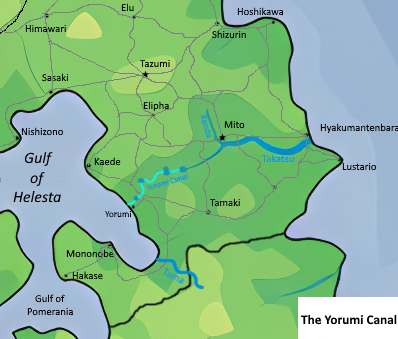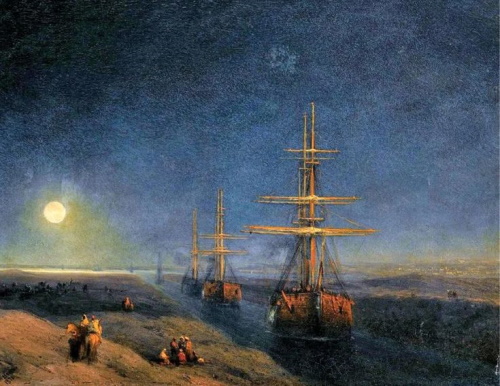The Great National Feat: The Yorumi Canal
The need for a canal to connect the Anykarian Sea to the Heavenly Sea had long been a goal of the Empire since antiquity. The boon such a canal would provide is obvious, as it would cut down on time traveled and allow merchants to avoid the Pirates that made up the Greater Anykarian Sea as well. But it was not until the coming of Trans-Heavenly trade in the 10th Century VTE that such a canal turned from a mere idea into a necessity for the Empire's growth.
Starting at its namesake, the City of Yorumi, the Canal stretches some 300 kilometres along the relatively flat area to series of small lakes and lagoons that are at the mouth of the Takatsu River. A complex series of locks around this region was required for the canal to function properly, but up to this point, there were 4 major locks that were needed despite the relatively flat nature of the land. The Canal has a depth of 6 metres and a width of 20 metres. Several lakes and lagoons were also incorporated into the Canal in order for the potential of two-way traffic. The total distance of the canal and the Takatsu River is 1000 kilometres, which for ships operating out of Suzuhara would mean they save around 9000 kilometres on their journey to the Heavenly Sea.

Construction of the canal began in 914 VTE under the order of the Mononobe Shogun, Mononobe Daisuke. Progress was slow for many years and only 50km had been completed 964 VTE. This changed when the famed military engineer Motoyoshi Toya entered the scene. Toya was rather unimpressed by the measures taken thus far to complete the canal, and many of the methods used thus far seemed to waste more time and money than anything. He implemented advanced dredging methods and brought in much more oxen, and mules to get things working faster.
With Toya's methods, the Canal picked up its rate of construction and by 984, had reached 150km, achieving a rate of 10 km per year. The Canal would reach 200 km by 1014 and by 1035 250km. The last 50 km were particularly hard due to the complex locks and terrain issues that were encountered and took 30 years alone to complete. On August 8th, 1072, the Canal formally opened to traffic with much pomp and circumstance.
The First vessel to transit the canal was a merchantman, Arashio Maru outbound to Antiocheia, completing its trip across the canal in 35 days. As of now, the waterway is the busiest manmade one in the world, with 25 ships each day starting or finishing its transit. As time goes along and technology advances, there are calls for more money to be spent into widening the canal and deepening it so that larger merchants and even ships of the line can one day transit it. But the funding and methods are not advanced enough for this to happen.
